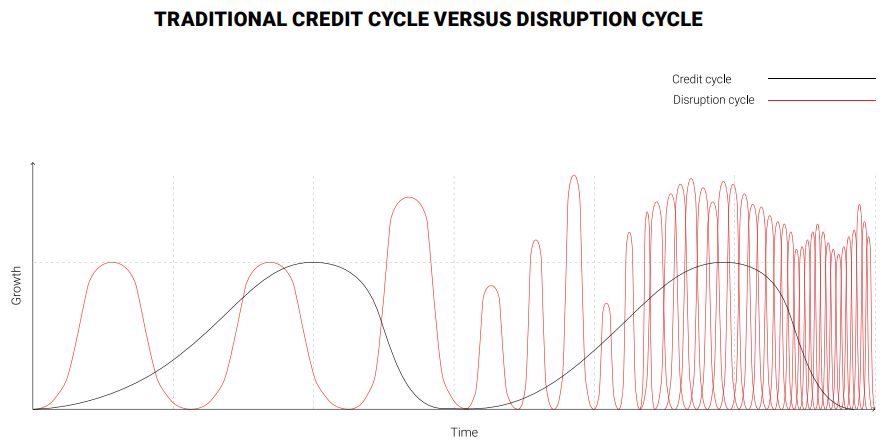Today, disruption, across industries, is happening more frequently and with overlapping and additive impact, causing major dislocations of shareholder value, revenue, profit, and jobs. This study was undertaken to better understand what is driving change within five major industries and identify successful strategies that companies are pursuing to respond to disruption in their industries.
Disruption is the new economic driver
The driving force of the economy is changing. The recognized phenomenon of the economic cycle, with its boom and bust of credit expansion and contraction, has historically driven the fortunes of business and the economy at large. As we saw during the 2008 financial crisis and the recession that followed, these factors remain important. However, the gaps between economic cycles have been lengthening in recent decades, and governments and business alike have become ever more adept at managing their effects. At the same time, the pace of disruption has accelerated dramatically, and its impact has magnified.

Whether we're talking about the fourth industrial revolution, consumer selfcentrism, climate change, or the rise of Asia, that accelerating pace and the cumulative impact of disruptive waves are the key driving forces in the economy and therefore represent the primary strategic challenges that both government and business leaders face today. Both the pace and the amplitude of the disruptive waves are increasing in frequency and overlapping to the point where disruption is becoming chronic. Whereas credit cycles will no doubt drive macroeconomic swings, the ability to manage disruption has become the critical commercial capability.
In a globalized economy, disruptions are rarely limited to the markets in which they originate. Disruption in one industry can have wide-ranging and often unpredictable ripple effects in many other industries and geographies, with significant macroeconomic implications. Consider, for example, the massive impact the telecommunications industry has had on media or the impact that connected consumers have had on retail. Disruption is creating dramatic dislocations and redistributions of revenue growth and profit.
When industrial performance correlated tightly with the credit cycle, business planning could be driven by expectations around economic expansion or contraction. We are now in the tenth year of global economic growth, the longest on record. This should be the best of times, and for some, it is. However, businesses across most industries struggle to cope with chronic disruption.
We define disruption as the displacement of businesses, markets, and value networks as the result of economic, societal, environmental, political, regulatory, or technological changes. Technological innovations can, in addition, serve as catalysts to accelerate other disruptive forces.
We know, of course, that disruption presents both opportunities and threats. But the now near-constant presence of disruption creates an even more pressing need for both private- and public-sector leaders to find new ways of anticipating, responding to and, where appropriate, creating these forces of change.
To understand this phenomenon in more detail, AlixPartners embarked on a project to study the causes of disruption in five industries–retail, consumer products, automotive, media, and telecommunications–to identify what leading organizations are doing to create, mitigate, and, in some cases, harness its effects
To view the full article please click here.
The content of this article is intended to provide a general guide to the subject matter. Specialist advice should be sought about your specific circumstances.
